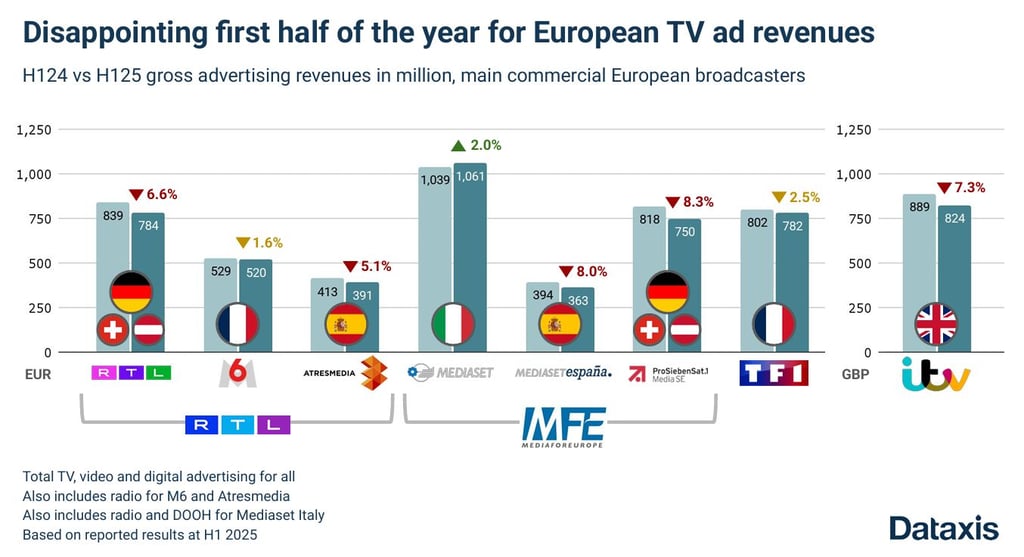TV advertising collapses in Europe: what if it's a crisis of substance, not just format?
As European media giants see their revenues decline, one thing is clear: reach alone no longer sells. Consumers expect more than just a well-placed ad—they want proof. That's why BuyTryShare puts trust back at the heart of advertising.
Stéphane LE BRETON
10/4/20256 min read


A disappointing start to 2025 for TV advertising revenues in Europe
The latest figures published by Dataxis sound like a warning for the European advertising market. In most major territories, gross revenues for commercial channels declined significantly in the first half of 2025:
⬇️ -8,3% for ProSiebenSat.1 (Germany, Switzerland, Austria)
⬇️ -7,3% for ITV (United Kingdom)
⬇️ -6,6% for RTL (Germany/Austria/Switzerland)
⬇️ -5,1% for Atresmedia (Spain)
⬇️ -2,5% for TF1 (France)
✅ The only notable exception is Mediaset Italy, which managed to record growth of +2.0% thanks to a more integrated media mix (radio, DOOH, digital).
This trend cannot be dismissed as a mere economic anomaly. It reveals a systemic fragility: linear audiences are holding up better than expected in several countries, but monetizing them is becoming increasingly complex.
The reach remains massive, but it is no longer enough to convince, let alone convert. Viewers are no longer captive. They are critical, informed, and suspicious. Advertising effectiveness is therefore no longer just a question of volume or targeting. It now depends on a factor that is more difficult to capture in GRPs: trust.
And it is precisely this divide between exposure and engagement that is jeopardizing the economic model of television advertising. More than a channel issue, it is a content issue.
A sense of déjà vu: after the press, television?
What European television is going through today is nothing new. We saw this movie before—in the press, a decade earlier. Between 2010 and 2020, advertising revenues for print media in France fell by more than 60% (source: ARCOM). In the United States, the collapse was even more dramatic: -70% between 2005 and 2020, according to Pew Research.
And yet, readership had not disappeared. In 2012, nearly 80% of French people still read a newspaper or magazine every week (source: ACPM). But confidence was declining. So were advertisers. The diagnosis was clear:
Media perceived as less agile
Campaigns deemed less measurable
Proof of effectiveness that is too vague in the face of the rise of programmatic advertising and digital KPIs.
The result: gradual disinvestment, falling CPMs, loss of value in use... to the point where certain titles have become totally dependent on subscriptions or public subsidies.
And today, linear television seems to be sliding down the same slope:
Audiences remain stable (e.g., +3% for France 2's prime time in H1 2025).
But advertising revenues are falling,
And young advertisers perceive it as an opaque, one-way channel, without proof or feedback.
If television simply speaks louder without proving itself more accurate, it could soon join the press in the category of media with a strong advertising history... and a bleak future without transformation.
The case of Le Parisien perfectly illustrates this mechanism. Despite a loyal readership and a strong brand, the daily newspaper recorded losses of €34 million in 2024, prompting its owner LVMH to consider selling it. The reason? A growing difficulty in proving its advertising value. In a market where budgets are being streamlined, advertisers no longer rely on brand awareness alone—they are looking for concrete evidence of impact. And without proof, investment no longer follows.
A dwindling audience, eroding trust
The usual reasons can be cited: fragmentation of usage, the rise of platforms, inflation of advertising formats. All these phenomena do indeed contribute to the decline in the effectiveness of traditional TV campaigns. But they do not explain everything.
Behind these structural dynamics lies a deeper, more pernicious cause: the loss of credibility.
Because it's not just audience numbers that are declining, it's active attention, engagement, and trust. Consumers no longer believe in it.
He has learned to decode advertising mechanisms. He recognizes the codes, the tricks, the intentions. And he protects himself from them. Even a prime-time commercial is no longer enough to convince viewers on its own. Too perfect, too scripted, too predictable—it is perceived as a marketing artifact, not a credible recommendation.
In a world where mistrust has become a reflex, where fake news coexists with deepfakes, every message is presumed false until proven otherwise.
And that is where the new challenge lies: the public no longer buys promises, it expects proof.
Repetition no longer sells. Exposure no longer inspires trust. Only proof creates a connection.
In tech, proof is a criterion for excellence
We can cite the classic reasons for advertising decline: fragmentation of usage, constant channel surfing, cognitive fatigue, and overwhelming competition from digital platforms. But behind these surface-level changes, a deeper reality is emerging: the public no longer takes advertising at face value.
The advertising model inherited from the 2000s was based on a simple equation: reach + repetition = memorization. But this equation no longer holds true. Memorization is no longer enough, because engagement no longer follows. Consumers have become evidence readers: they demand facts, guarantees, and feedback. Every advertising promise is initially met with skepticism. Every claim is subject to verification. In this new context, proof is the norm. And what is happening in the tech sector is the clearest illustration of this.
The TechRadar Sustainability Awards, for example, they no longer reward brands for their environmental rhetoric, but for their measured impact: energy savings, product life cycle, repairability index, etc. Storytelling has been relegated to the background. What matters is what has been demonstrated. And this movement is spreading to all sectors:
In mass retail, products display Nutri-Score, Yuka, or eco-design ratings.
In finance, extra-financial ratings (ESG) determine investment flows.
In cosmetics, organic or cruelty-free labels influence purchases more than packaging.
Everywhere, performance is measured by proof. And not just by image. So why should TV advertising be the only one that can do without it? Why continue to invest millions in polished commercials with no proof to back them up, when the entire marketing ecosystem is reorganizing around demonstration? In a world where mistrust is systemic, broadcasting a polished commercial with no proof is like broadcasting an empty message. Creativity alone is no longer enough. You need an anchor in reality. External validation. Visible proof.
By 2025, branding without proof is a luxury that few brands can still afford.
BuyTryShare turns every ad into visible proof
That is precisely BuyTryShare's mission: to bring proof to the heart of traditional media.
By integrating certified consumer reviews (ISO 20488 / NF522) directly into TV, cinema, or press campaigns.
By creating short formats (5 seconds) that extend a commercial with real, visible, traceable testimonials.
By putting what sells back at the center of the equation: trust.
⚡️ An authentic review = proof. Proof = impact. It's as simple as that. What if TV regained its value through proof, not pressure?
BVoD platforms are gaining momentum... but remain fragile without proof
Faced with pressure on their advertising revenues, audiovisual groups are accelerating their transformation: more detailed segmentation of offerings, linear/digital hybridization, new attention metrics, AI, and automated purchasing. In France, TF1 Pub, France Télévisions Publicité, and M6 Publicité are adopting convergent strategies:
Overhaul of inventories, with packages themed by moments, screens, or target audiences;
Launch of transactional platforms, such as TF1 Ad Manager or M6's data-driven offerings;
Enriched KPIs, going beyond GRP: attention, co-viewing, carbon footprint, CSR impact.
In terms of usage, the BVoD trend is accelerating:
TF1+ has reached a milestone with 42.5 million unique monthly visitors and 40% growth in advertising revenue in H1 2025. Its integration into Netflix in 2026 marks a turning point: the group's content will be available in 22 countries and exposed to a global audience, including on AVoD.
France.tv remains the leader in terms of volume with 46.6 million unique visitors, a position that has been strengthened since the integration of its offering into the Amazon Prime Video ecosystem, effective since July 2025.
M6+ follows at 32 million viewers, with growth more focused on commercial targets.
But this rise in power raises a structural question: what if technology and reach are no longer enough? In a context where algorithmic optimization is becoming the norm, there is a risk of forgetting the essential: the credibility of the message being conveyed.
Without proof embedded in the advertising content itself, even the most intelligent platforms will fail to convince an audience that has become adept at detecting overly polished discourse.
👉 Targeting accurately, yes. But proving it true, even more so.
Advertising has a future, if it agrees to be proven
The decline in revenue is not inevitable. It is a signal. A signal that it is time to reconcile two worlds that advertising has long pitted against each other: power and proof.
✅ No, evidence does not kill creation. It legitimizes it. It supports it. It makes it actionable.
This is precisely what BuyTryShare makes possible: inserting authentic validation into the most powerful formats, without sacrificing visual impact or premium branding.
Ads that don't just show. They show that you can believe.
Our commitment
Reviving trust in brand advertising through innovation.
CONTACt
info@buytryshare.com
+33 6 83 53 70 41
© 2025. SLB consulting. All rights reserved.



